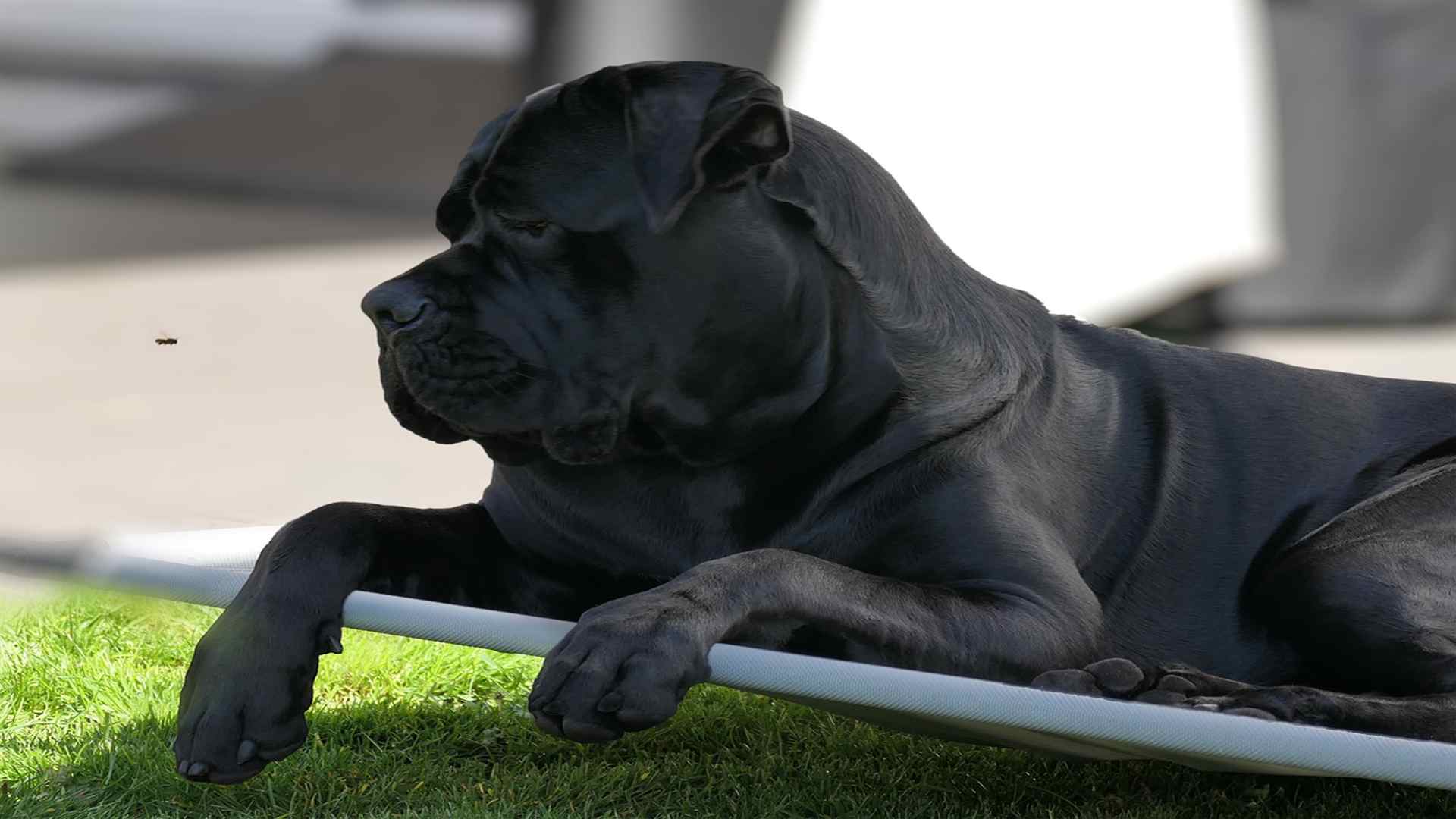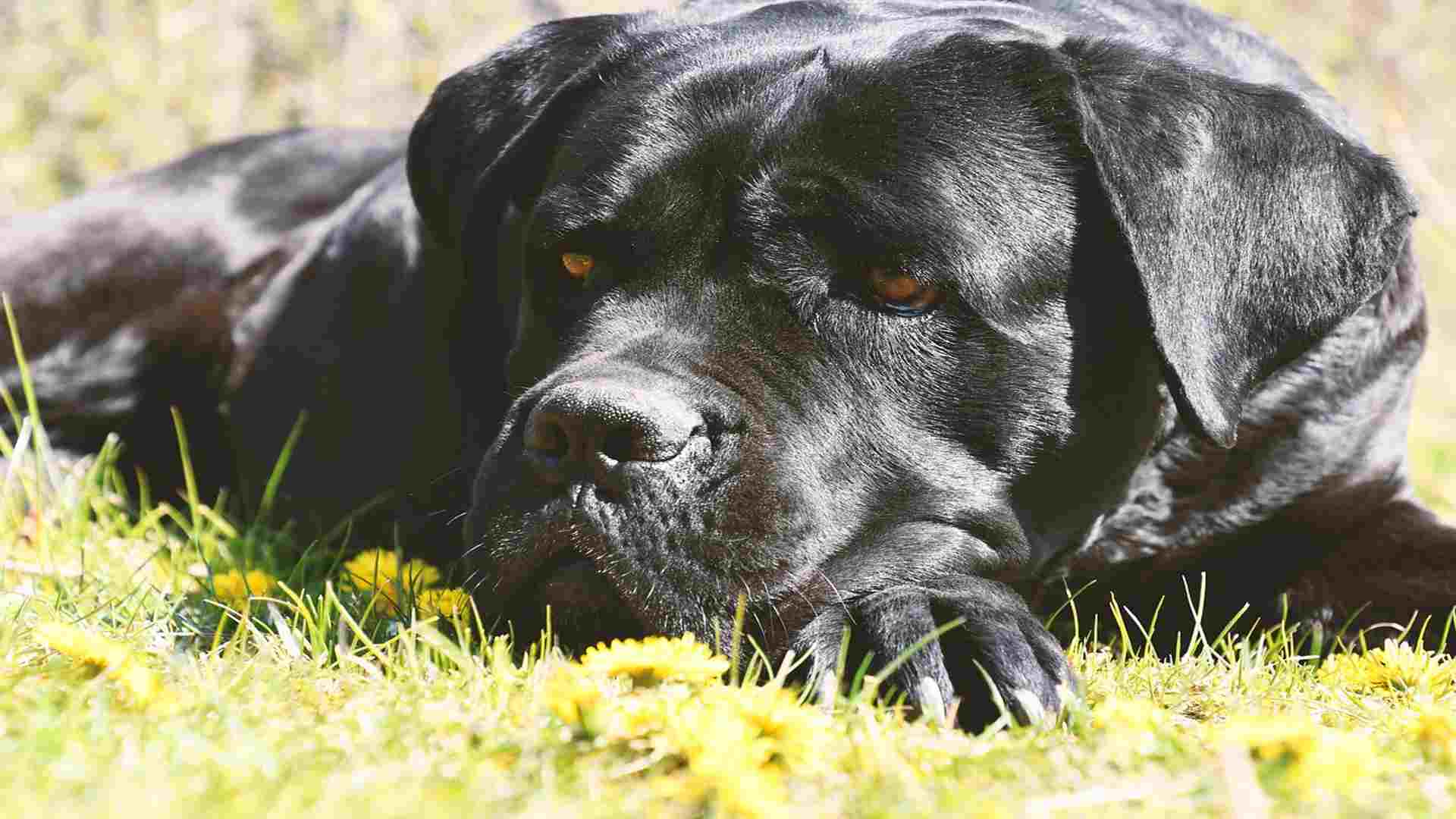If you’re a dog lover, you’ve probably heard of the Cane Corso breed. But have you heard of the blue brindle variation?
This unique coat color is highly sought after by enthusiasts, but there’s more to this breed than just their striking appearance. In this article, we’ll dive into the history, appearance, temperament, and care of the Cane Corso Blue Brindle.
Whether you’re considering adding one to your family or just curious about this fascinating breed, read on for all the tips and insights you need to know.
Let’s begin!
Cane Corso Blue Brindle: An Overview

Cane Corso is a large and powerful dog breed that originated in Italy. They are known for their loyalty, intelligence, and protective nature. The blue brindle Cane Corso is a rare color variation that is highly sought after by dog enthusiasts.
Blue brindle is a unique coat color that combines shades of blue and brindle. The blue coloration is caused by a dilution gene that affects the production of melanin. The brindle pattern is caused by the interaction of the brindle gene with other genes that control the distribution of pigment.
Blue brindle Cane Corsos are often confused with blue or gray Cane Corsos. However, the blue brindle pattern is distinct and can be easily recognized by its unique combination of colors.
The rarity of the blue brindle Cane Corso makes them highly desirable among dog lovers. However, it is important to note that color should not be the only factor when choosing a dog. Temperament, health, and breed characteristics should also be considered.
Origin and history
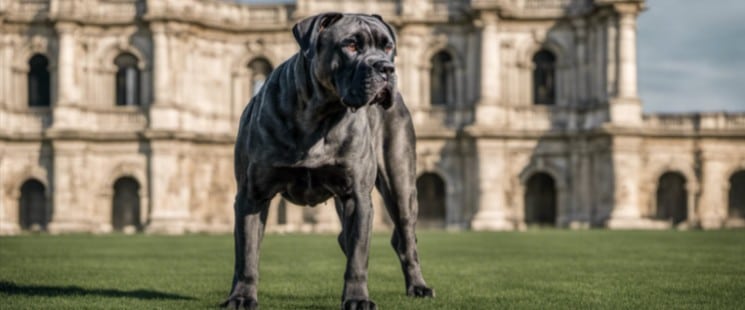
Cane Corso Blue Brindle is a breed of dog that originated in Italy. The breed’s history can be traced back to ancient Roman times, where they were used as guard dogs and hunting companions. The Cane Corso is a descendant of the Molossus, a large dog breed used by the Romans in warfare.
The Cane Corso’s name comes from the Latin word “cohors,” which means “protector” or “guardian.” The breed was primarily used in Italy as a guardian of property, livestock, and families.
Cane Corso history is closely linked to the history of Italy. The breed was almost extinct after World War II, but a group of enthusiasts worked hard to revive the breed in the 1970s.
The breed was recognized by the Italian Kennel Club in 1994 and has since become increasingly popular in Europe and North America.
The Blue Brindle Cane Corso is a unique color variation of the breed. The blue brindle color is a result of a recessive gene that causes a dilution of the black pigment in the coat. This color variation is highly sought after by breed enthusiasts.
What is the temperament of a blue brindle Cane Corso?
The temperament of a blue brindle Cane Corso is generally calm, loyal, and protective. They are known for being affectionate with their families and can be good with children if socialized properly.
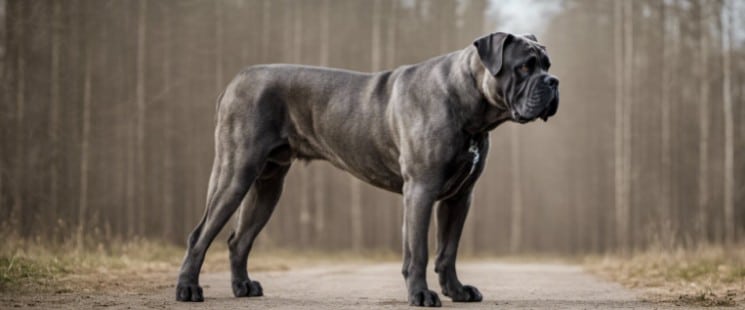
However, they can also be wary of strangers and may require early socialization to prevent aggression towards unfamiliar people or animals. Training and socialization are important for this breed, as they can be strong-willed and require a firm hand.
Breed standards and appearance
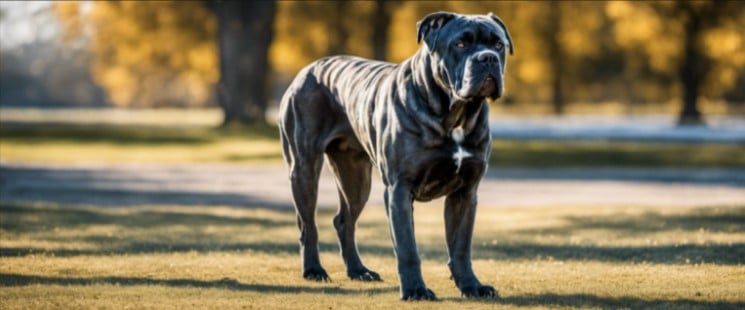
As breeders and enthusiasts of the Cane Corso Blue Brindle, we understand the importance of adhering to the breed standards set forth by the American Kennel Club (AKC).
The breed standard serves as a blueprint for the ideal Cane Corso, encompassing both physical and behavioral traits.
In terms of appearance, the Cane Corso Blue Brindle is a powerful and muscular breed, with a broad head and strong jaws.
Their coat is short and dense, with a glossy sheen. The blue brindle coloration is a unique and striking feature, with a base color of blue-grey and darker brindle stripes.
The AKC standard specifies that the ideal male Cane Corso should stand between 25 and 27.5 inches at the shoulder, with females slightly smaller at 23.5 to 26 inches.
Weight should be proportionate to height, with males weighing between 90 and 120 pounds and females between 80 and 110 pounds.
Other important physical features specified in the breed standard include:
- A broad, flat skull with a defined stop
- Dark, almond-shaped eyes
- A broad, deep chest
- Straight, muscular legs with well-defined musculature
- A docked tail that is set high and carried erect
In addition to physical traits, the breed standard also outlines desirable behavioral characteristics. Cane Corsos should be confident, loyal, and protective of their families while also being calm and well-behaved in public. Aggression towards humans or other animals is not acceptable.
Color and genetics
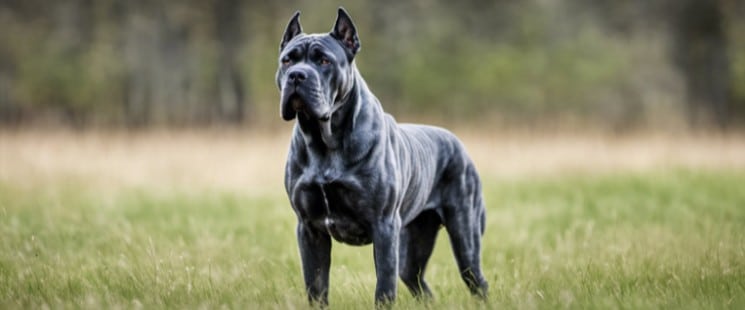
Cane Corso dogs come in a variety of colors, including gray, black, red, and blue. The color of a Cane Corso is determined by genetics, specifically the inheritance of certain genes from their parents.
The blue color in Cane Corsos is caused by a recessive dilute gene. When a Cane Corso inherits two copies of this gene, one from each parent, they will have a blue coat. Blue brindle and black brindle are also possible color variations, with the brindling pattern being caused by a separate gene.
Gray brindle is another possible color variation, with the gray coat being caused by a different gene than the brindle pattern.
It is important to note that gray Cane Corsos are not the same as blue Cane Corsos, as the gray color is not caused by the dilute gene.
While blue Cane Corsos are highly sought after for their unique coloring, it is important to be aware of the potential health issues associated with the dilute gene.
Color dilution alopecia is a condition that can affect dogs with diluted coats, causing hair loss and skin irritation.
Temperament and personality
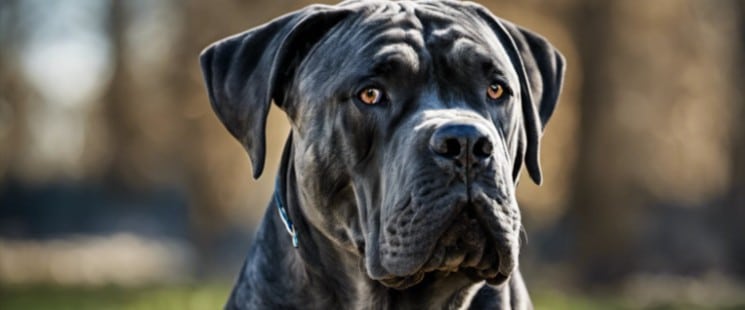
Cane Corso Blue Brindles are known for their loyal and protective temperament. They are intelligent dogs with a dominant personality, which can make them intimidating to strangers.
However, with proper training and socialization, they can be reliable and gentle companions.
As guardians and protectors, Cane Corso Blue Brindles are naturally sensitive and cautious.
They are affectionate with their families and assertive when it comes to guarding their territory.
They can be headstrong at times, so it’s important for owners to establish themselves as the pack leader early on.
Despite their size and strength, Cane Corso Blue Brindles have a gentle side. They are known to be affectionate with their families and can be quite playful.
However, they are not recommended for households with small children or other pets, as their guarding instincts can kick in.
Training and socialization
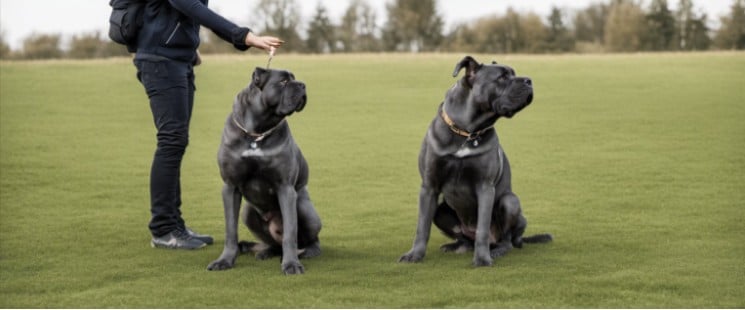
Training and socialization are essential for any dog, and the Cane Corso Blue Brindle is no exception. As responsible owners, we must ensure that our dogs are trained and socialized properly to prevent any behavioral issues in the future.
When it comes to training, consistency is key. We must establish ourselves as the pack leader and use positive reinforcement techniques to encourage good behavior.
It’s important to start training at a young age to establish good habits early on. We should also provide plenty of mental and physical stimulation to keep our dogs engaged and prevent boredom.
Socialization is also crucial for the Cane Corso Blue Brindle. We should expose our dogs to a variety of people, animals, and environments to help them become well-adjusted and confident.
It’s important to note that socialization doesn’t just mean exposing our dogs to new things.
We must also teach them appropriate behavior around people and other animals. We can use positive reinforcement techniques to reward good behavior and redirect unwanted behavior.
Health and lifespan
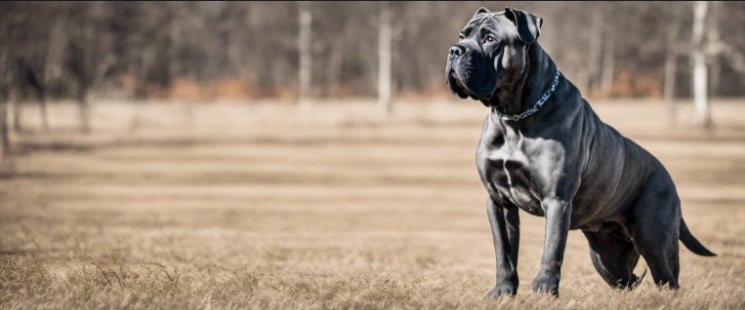
When it comes to the health and lifespan of a Cane Corso Blue Brindle, there are a few things to keep in mind. Overall, the breed is generally healthy and has a lifespan of 9-12 years.
However, like all breeds, there are some health issues that can arise. Here are a few to be aware of:
- Hip dysplasia. This is a common issue for many large breeds; the Cane Corso is no exception. Having your dog screened for hip dysplasia is important, as it can lead to arthritis and other problems later in life.
- Elbow dysplasia. This is another joint issue that can affect Cane Corsos. It’s also important to have your dog screened for this condition.
- Bloat. This serious condition can occur when a dog’s stomach fills with gas and twists. It can be life-threatening, so it’s important to know the signs and get your dog to a vet right away if you suspect bloat.
- Eye conditions. Cane Corsos can be prone to a few different eye conditions, including entropion (where the eyelid rolls inward), ectropion (where the eyelid rolls outward), and cherry eye (where the third eyelid prolapses). While these conditions are not usually life-threatening, they can be uncomfortable for your dog and may require treatment.
Size, weight, and physical exercise
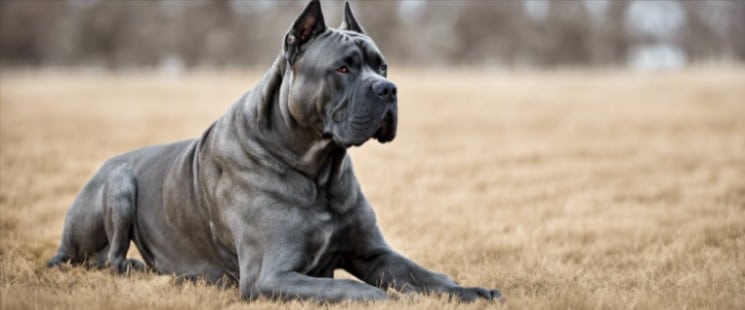
When it comes to the Cane Corso Blue Brindle, size and weight are two important aspects that potential owners should consider. These dogs are large and muscular, with males typically weighing between 99 and 110 pounds and standing 25 to 27 inches tall at the shoulder.
Females are slightly smaller, weighing between 88 and 99 pounds and standing 23.5 to 26 inches tall.
Due to their size and strength, these dogs require regular physical exercise to stay healthy and happy.
We recommend providing your Cane Corso Blue Brindle with at least 30 to 60 minutes of moderate to intense exercise each day. This can include activities such as brisk walks, jogs, or runs, as well as games of fetch or tug-of-war.
It’s important to note that these dogs have a lot of energy and need plenty of opportunities to burn it off.
Without enough exercise, they may become bored or restless, which can lead to destructive behavior.
Role and popularity
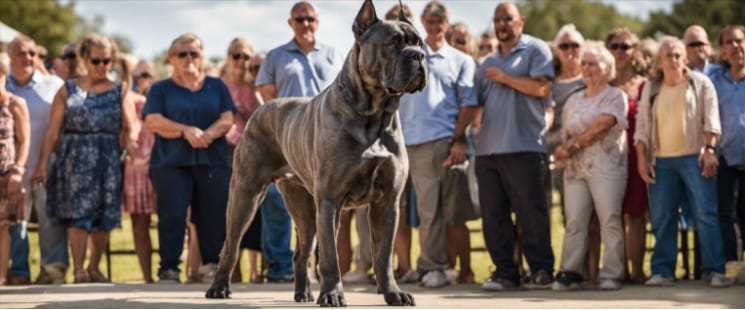
Cane Corso Blue Brindle is a breed of dog that is known for its strength, intelligence, and loyalty. They are often used as working dogs, particularly as guard dogs for property and livestock. They are also known to be used in hunting wild boar.
The Cane Corso Blue Brindle is a relatively new breed, but it has quickly gained popularity among dog lovers around the world. This breed is known for its striking appearance, with a muscular build and a distinctive blue brindle coat.
They are also known for their calm and confident demeanor, making them ideal for families with children.
One of the reasons for the breed’s popularity is its versatility. Cane Corso Blue Brindles are not only great guard dogs, but they are also loyal companions and excellent family pets. They are intelligent and easy to train, making them a popular choice for those who want a dog that can be both a protector and a friend.
Apart from their popularity as pets, Cane Corso Blue Brindles are also used in various working roles. They are often used as police dogs, search and rescue dogs, and even therapy dogs.
Their strength and intelligence make them well-suited for these roles, and they are often highly valued by their handlers.
Caring for a Cane Corso Blue Brindle
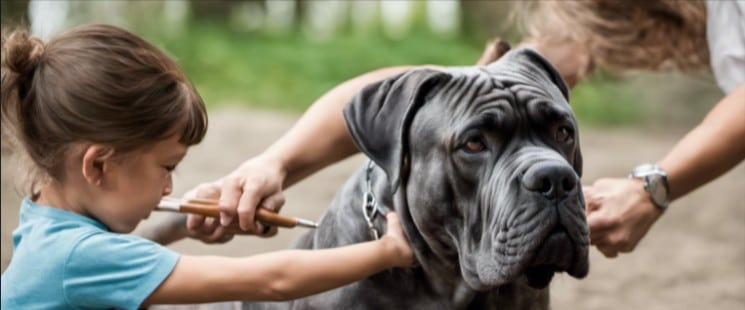
Cane Corso Blue Brindles are a unique breed that requires proper care and attention. As responsible owners, we must ensure that our pets are well looked after and provided with everything they need to lead a happy and healthy life.
When it comes to caring for a Cane Corso Blue Brindle, there are a few things to keep in mind. Firstly, it is important to provide them with a balanced diet that meets their nutritional needs. This means feeding them high-quality dog food and avoiding foods that are harmful to their health.
Cane Corso Blue Brindles require mental stimulation to keep them engaged and active. This can include activities such as playing with toys, going for walks, and training sessions.
Creating a safe and comfortable environment for your pet is also important. This includes providing them with a suitable living space, such as a crate or dog bed, and ensuring that they have access to clean water and a comfortable temperature.
When it comes to interacting with children and adults, Cane Corso Blue Brindles can be loyal and affectionate pets. However, it is important to supervise interactions and ensure that both the pet and the person are comfortable and safe.
Finally, if you live on a farm, it is important to ensure that your Cane Corso Blue Brindle is properly trained and socialized. This will help to prevent any potential conflicts with other animals on the farm.
Summary
Before we move on to the conclusion, we’ve summarized this article into a short list of key points for you to remember:
- The Cane Corso is a large and powerful dog breed that originated in Italy and is known for its loyalty, intelligence, and protective nature.
- The blue brindle Cane Corso is a rare color variation that is highly sought after by dog enthusiasts, but it is important to prioritize other factors when choosing a dog, such as temperament, health, and breed characteristics.
- The breed’s history can be traced back to ancient Roman times, where they were used as guard dogs and hunting companions, and the breed was almost extinct after World War II but was revived in the 1970s.
- The Cane Corso Blue Brindle is a stunning and powerful breed that embodies the ideal combination of physical and behavioral traits outlined in the AKC breed standard, but training, socialization, and proper health care are crucial for this breed.
To sum up
While their rarity and color make them highly desirable among dog lovers, it’s important to prioritize other factors when choosing a dog, such as temperament, health, and breed characteristics.
Want to learn more about Cane Corso?
Ready to boost your knowledge to the next level? If so, check out the articles below:
- Do Cane Corsos Enjoy Swimming? (Important Facts)
- 7 Best Unique Dog Collars for Cane Corso – Expert Tips
- How Much Do Cane Corsos Shed? (Tips for New Owners)




